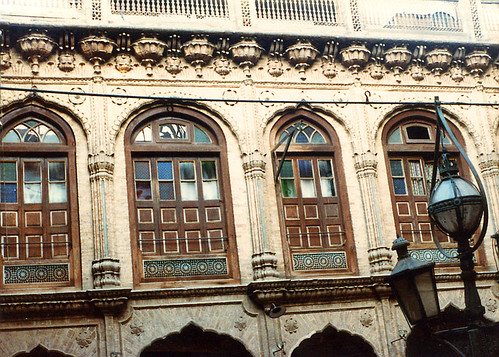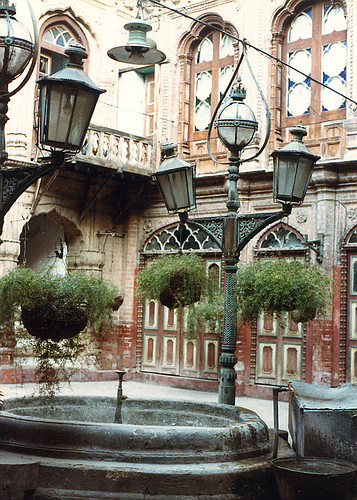 One of the oldest parts of the city situated in the heart of Peshawar, Mohalla Sethian presents a fine series of 18th and 19th century architecture. It depicts a mixed artisanship of Bukhara, Kashmir, Golkanda and Iranian cultures. The roofs of these palatial mansions or havelis located in Bazaar-i-Kalan are connected to each other by wooden bridges, depicting a kaleidoscopic world inside the weather-beaten, brick-walled houses. The havelis speak volumes about the aesthetic sense and love for embellishments of their once-rich occupants. The small Kashmir bricks known as Waziri were used in the Mughal era from Lahore to Agra. The use of limestone, colourful glasswork, embossed settings of flowers on wooden doors, windows, frames, arches and columns and aroosi engraved by Bukhara artisans take any visitor to the bygone days when Peshawar was ruled by exiled Afghan princes. Sethis were the businessmen of Peshawar. These traders earned huge profits in trade with India, Afghanistan and Central Asia. The palatial residence of the Sethis, built in 1882 by Haji Ahmad Gul, is proof of this fact. Ahmad Hasan Dani, in his book Peshawar - Historic City of the Frontier, describes the palatial residence of the Sethis. He says: "It is a highly-embellished building in the typical style of the domestic architecture of a rich man, presenting highly-carved wooden doors, balconies, a mirrored and painted reception room with open upper storeys to catch the fresh breeze and underground rooms in two stages for protection from the summer heat. A highly-carved wooden doorway leads into a court where business was transacted. A bent passage gives access to the interior. The main house forms round an open court, 32x30, paved with bricks. The surrounding rooms show highly-carved wooden arches resting on pillars with panels showing variegated motifs...the whole building gives an appropriate idea of the old type of houses." The three-storey building consisting of a tehkhana, balakhana and a dalan opening through a triple-arched entrance has a colourfully-painted ceiling. An interesting feature of these buildings is the colourful ceilings designed and painted in different colours in every room. The variety in design and paint of the ceiling and colour combination is awe-inspiring. The cut-glass fixed on the walls reflects the colourful panels embellished with antiques and vases. Hundred-year-old chandeliers in blue and yellow, imported from Belgium, enhance the beauty of the room.Muhalla Sethian would have attracted more tourists if it were open to them, but it is still inhabited by the Sethis and the beauty and grandeur is inaccessible to the public. This old and historic Muhalla should be preserved.
One of the oldest parts of the city situated in the heart of Peshawar, Mohalla Sethian presents a fine series of 18th and 19th century architecture. It depicts a mixed artisanship of Bukhara, Kashmir, Golkanda and Iranian cultures. The roofs of these palatial mansions or havelis located in Bazaar-i-Kalan are connected to each other by wooden bridges, depicting a kaleidoscopic world inside the weather-beaten, brick-walled houses. The havelis speak volumes about the aesthetic sense and love for embellishments of their once-rich occupants. The small Kashmir bricks known as Waziri were used in the Mughal era from Lahore to Agra. The use of limestone, colourful glasswork, embossed settings of flowers on wooden doors, windows, frames, arches and columns and aroosi engraved by Bukhara artisans take any visitor to the bygone days when Peshawar was ruled by exiled Afghan princes. Sethis were the businessmen of Peshawar. These traders earned huge profits in trade with India, Afghanistan and Central Asia. The palatial residence of the Sethis, built in 1882 by Haji Ahmad Gul, is proof of this fact. Ahmad Hasan Dani, in his book Peshawar - Historic City of the Frontier, describes the palatial residence of the Sethis. He says: "It is a highly-embellished building in the typical style of the domestic architecture of a rich man, presenting highly-carved wooden doors, balconies, a mirrored and painted reception room with open upper storeys to catch the fresh breeze and underground rooms in two stages for protection from the summer heat. A highly-carved wooden doorway leads into a court where business was transacted. A bent passage gives access to the interior. The main house forms round an open court, 32x30, paved with bricks. The surrounding rooms show highly-carved wooden arches resting on pillars with panels showing variegated motifs...the whole building gives an appropriate idea of the old type of houses." The three-storey building consisting of a tehkhana, balakhana and a dalan opening through a triple-arched entrance has a colourfully-painted ceiling. An interesting feature of these buildings is the colourful ceilings designed and painted in different colours in every room. The variety in design and paint of the ceiling and colour combination is awe-inspiring. The cut-glass fixed on the walls reflects the colourful panels embellished with antiques and vases. Hundred-year-old chandeliers in blue and yellow, imported from Belgium, enhance the beauty of the room.Muhalla Sethian would have attracted more tourists if it were open to them, but it is still inhabited by the Sethis and the beauty and grandeur is inaccessible to the public. This old and historic Muhalla should be preserved.
















0 comments:
Post a Comment